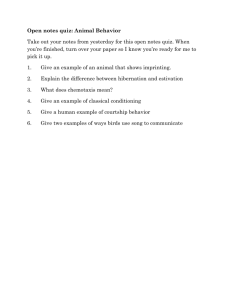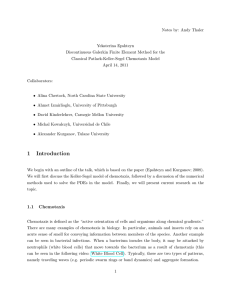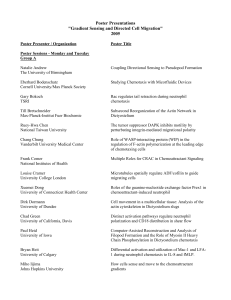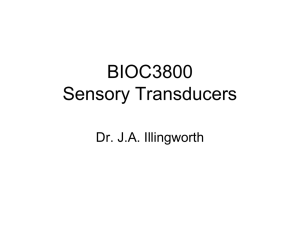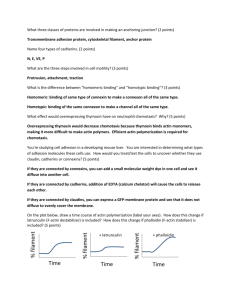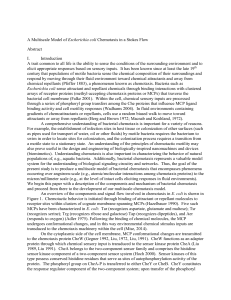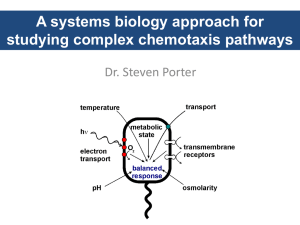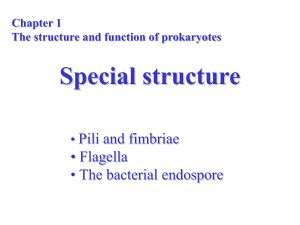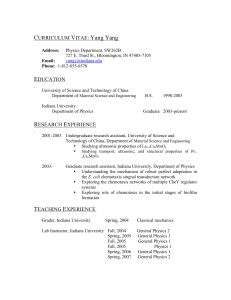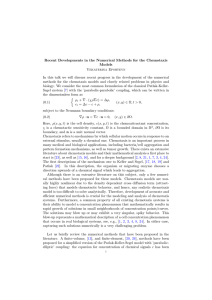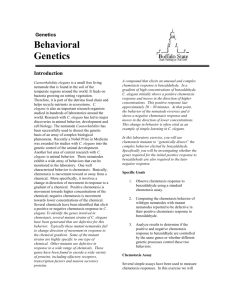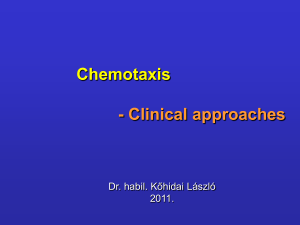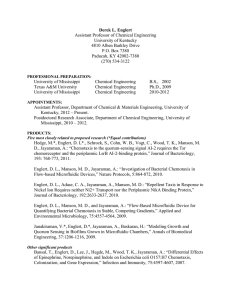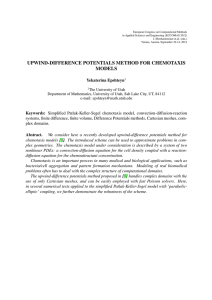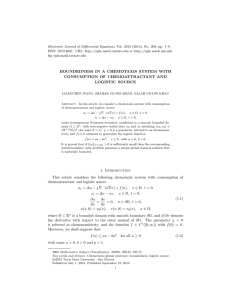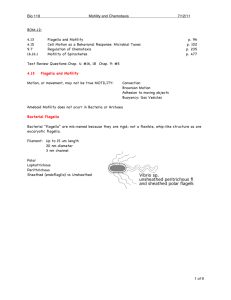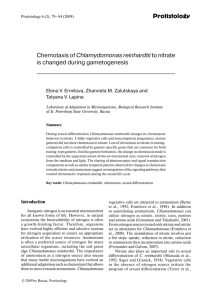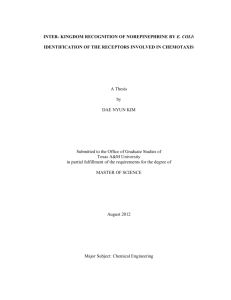The Case of Bacterial Chemotaxis
advertisement
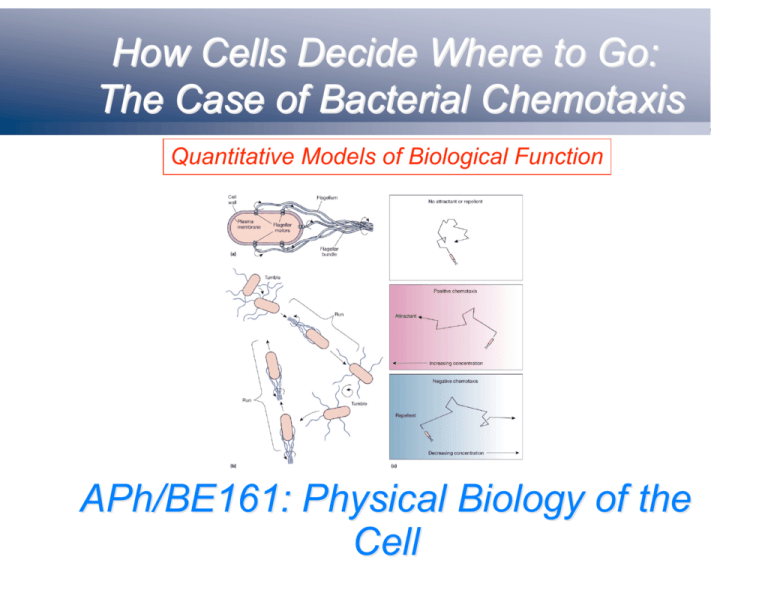
How Cells Decide Where to Go: The Case of Bacterial Chemotaxis Quantitative Models of Biological Function Mannella et al. APh/BE161: Physical Biology of the Cell Theriot et al. Neutrophil Chasing a Bacterium: The Great Themes of Biology How do cells decide? How do cells move? How do cells differentiate into different types? Neutrophil Chemotaxis A Cell's Sense of Direction Carole A. Parent and Peter N. Devreotes lMacrophage Performing Phagocytosis: More Great Themes of Biology How do cells recognize other objects - molecular recognition? How do cells metabolize products from the external world? You can see fluorescent actin being recruited to ( and presumably polymerized near) a 5 micron anti-body coated bead. The 1st step is the formation of a "phagosomal actin cup". That's the fluorescent blob at the base of the 5micron bead. The actin front then works around the perimeter of the bead, to pinch the membrane closed at the opposite end. After the bead is engulfed, the actin filaments then de-polymerize and redistributes through out the cell. Leukocyte Rolling The workings of the immune system. From Alberts et al., “Molecular Biology of the Cell” Once again, a microcosm of many of the great themes and questions in biology (and all of science, for that matter). Neutrophils and Inflammation Electron micrograph of a neutrophil migrating through an endothelial cell barrier During inflammation, the neutrophil migrates from the bloodstream by binding to receptors on the surface of the endothelial cell which lines the blood vessel. http://www.irishscientist.ie/2002/contents.asp?contentxml=02p26b.xml&contentxsl=is02pages.xsl Neutrophils and Inflammation Time-lapse movie of isolated PMN before and after PMA stimulation. Every 5 sec one frame was taken, the time-lapse factor is 120. Unstimulated, the cells are highly motile but stay spheroid most of the time. After addition of PMA (small image shift after half of the movie), the cells flatten considerably but remain highly motile. The last frame was taken after addition of the cell impermeant DNA dye Sytox Green which stains NETs. In the area of NETs, no dead cells are visible. History of Studies of Chemotaxis Although migration of cells was detected from the early days of the development of microscopy (Leeuwenhoek), erudite description of chemotaxis was first made by T.W. Engelmann (1881) and W.F. Pfeffer (1884) in bacteria and H.S. Jennings (1906) in ciliates. The Nobel prize winner E. Metchnikoff also contributed to the study of the field with investigations of the process as an initial step of phagocytosis. The significance of chemotaxis in biology and clinical pathology was widely accepted in the 1930s. The most fundamental definitions belonging to the phenomenon were also drafted by this time. The most important aspects in quality control of chemotaxis assays were described by H. Harris in the 1950s. In the 1960s and 1970s, the revolution of modern cell biology and biochemistry provided a series of novel techniques which became available to investigate the migratory responder cells and subcellular fractions responsible for chemotactic activity. The pioneering works of J. Adler represented a significant turning point in understanding the whole process of intracellular signal transduction of bacteria.[1] Bacterial Chemotaxis as a Case Study Bacterial chemotaxis refers to motility preferences expressed by bacteria in the presence of chemical stimuli. Motion is characterized by a series of runs and tumbles. Bias is provided by reducing the number of tumbles when a run is in a “good” direction. Flagellar Organization Berg and Turner Flagellar Rotary Motor Berg Bacterial Chemotaxis as a Case Study Signaling network mediates chemotactic decision making. Chemoattractants detected at the cell surface by membranebound receptors. The Chemotaxis Receptors http://www.pdn.cam.ac.uk/groups/comp-cell/Research.html Receptor Localization Kentner and Sourjik Protein Modifications http://employees.csbsju.edu/hjakubowski/classes/ch331/protstructure/posttran.gif Post-Translational Modifications ``Expanding Nature’s Inventory” - see the book, “Posttranslational Modification of Proteins” by Christopher Walsh. In the chemotaxis case, phosphorylation and methylation play a key role. In vivo FRET Beautiful in vivo experiment done to monitor the association of key proteins in the chemotaxis pathway. Idea of the experiment: make fusion proteins with different fluorescent partners that can participate in FRET. Sourjik and Berg Bacterial Chemotaxis as a Case Study: Experimental Analysis Endres, Wingreen et al. Monitor interaction of CheY (signaling intermediate) and its phosphatase. This effectively monitors the KINASE activity. Low activity means that the cell likes the way things are going - reduce the tumble probability.
